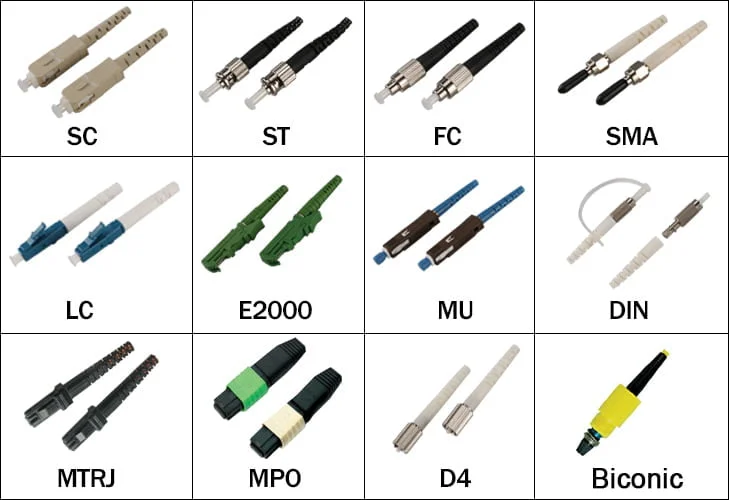Fiber connection types are quite diverse when compared to Copper wires. Whereas copper twisted pairs typically terminate with an RJ45 connection, fiber optic connectors exist in a variety of forms and sizes to accommodate a variety of different use cases. Fibre connector types, also called terminations, are used to connect fiber optic cables via patch panels, switches, terminals, and adapters. The fiber connectors bridge the gap between the internal glass fibers of the cables, allowing the data to be sent down the length of the cable.
All fiber optic cable connections are made to a high quality since they must be extremely exact. Some are made with higher-performance aims in mind, while others are made to a more durable standard.
Here's all you need to know about the various fiber optic connection choices available.
Why Different Connectors Exist
The wide variety of fiber connection types can be related to several factors. First, various cables are made for different kinds of tasks. There are connections for both single-mode and multimode fiber optic cables. There are connections designed to provide higher in-socket stability, so they cannot simply fall out or be wrenched free when in place. Certain connectors include two connections, whereas others only have one.
Some connectors are meant to be more robust or to provide additional protection for the cable itself, such as having a longer boot, whereas others are not, with shorter boots. Some connections are both bigger and smaller.
Fiber Optic Connector Types
There are several fiber connector types, and listing them all would make this article much too long and incomprehensible. Instead, here are some of the most visible, essential, and generally available fiber optic connections available today, along with an explanation of why you would prefer one over the other.
Lucent Connectors (LC)
Lucent Connectors, or LC connectors are small form factor solutions for fiber optic connections. With ferrules measuring just 1.25mm in thickness, they are ideal for densely populated patch panels and cabinets where space is limited. LC connectors are commonly used in both multimode and single-mode fiber optic cables, known for their sturdiness once connected, though this can pose challenges when attempting to remove individual LC connector fiber cables. Network administrators often employ LC connector extraction tools to facilitate the removal process.
Standard Connectors (SC)
SC connectors were developed by the Japanese telecoms company, NTT, and are colloquially known as Standard Connectors or SC Connectors. They're a square-shaped, duplex connector that uses a 2.5mm ferrule and has a push-pull mechanism to latch them in place, ensuring robustness. This older connection has been a standard for a long time and has seen extensive usage in networks worldwide.
While its square shape is useful for fitting into smaller spaces, more modern, space-saving connectors like LC connectors are becoming more popular in newer network rollouts, gradually replacing SC fiber optic connectors.
ST Connectors
ST connectors, developed by AT&T, were among the first fiber connector types widely adopted in global fiber optic networks. The Straight Tip (ST) design features a 2.5mm ferrule, similar to SC connectors, and can be used interchangeably with them when using a hybrid adapter. It utilizes a spring-loaded, half-turn bayonet-style lock for quick and secure attachment and detachment, reducing the risk of accidental disconnects.
ST connectors are typically used with multimode fiber optic cables and are common in legacy networks, though they are gradually being replaced by newer alternatives.
Ferrule Core Connectors (FC)
FC connectors are named for their ceramic ferrule and stainless steel screw mechanism, setting them apart from the plastic-bodied SC and LC connectors. FC connectors offer a robust, secure connection that resists accidental disconnection, ensuring uninterrupted data flow.
However, the keyed screw mechanism of FC connectors requires more effort for installation and removal, making them less suitable for confined spaces. Yet, the reliability of the connection outweighs this inconvenience.
These connectors are commonly used with single-mode fiber optic cables in networks that require continuous data transmission, such as video streams. Any disruption in the data connection would be immediately noticeable. However, in newer networks, LC and SC connectors are preferred for their ease of use, leading to a decline in FC connector usage.
Multi-Position Connectors (MPO)
MPO connectors, sometimes marketed interchangeably with MTP connectors, feature a simple push/pull latch system for secure locking. MTP, primarily a branding choice, was designed for higher-performance networks, while MPO connectors are often intended for less demanding applications.
Both work with single-mode and multimode cables, with a slightly angled ferrule for single-mode. They are frequently used in high-bandwidth multimode cables, combining up to 24 glass fibers within a single rectangular ferrule.
MT-RJ Connectors
MTRJ (Mechanical Transfer-Registered Jack) connections are duplex connectors designed by AMP/Tyco and Corning. They are both male and female, and they employ pins for alignment. Once joined, the plastic body of the device is secured in place by a tubular locking mechanism.
Although they are still occasionally utilized in older networks and systems, they are among the least popular types of fiber connectors used today. MTRJ connectors have been used in more compact patch panels and cabinets with small ferrules, primarily with multimode cables.
Fiber Optic Connectors by Dintek
Dintek offers a wide range of fiber optic cables, including various connector types and adapters for connecting to patch panels or other cables. You can purchase LC to LC duplex OS2 cables in various lengths, and our LC to LC duplex fiber optic adapters allow you to connect multiple LC cables.
For those building a patch panel, you'll need suitable keystone jacks. Dintek offers patch panels pre-fitted with LC and other connector types. Alternatively, you can choose a blank patch panel for rack or wall mounting and then install keystone jacks of your preference.


No comments yet